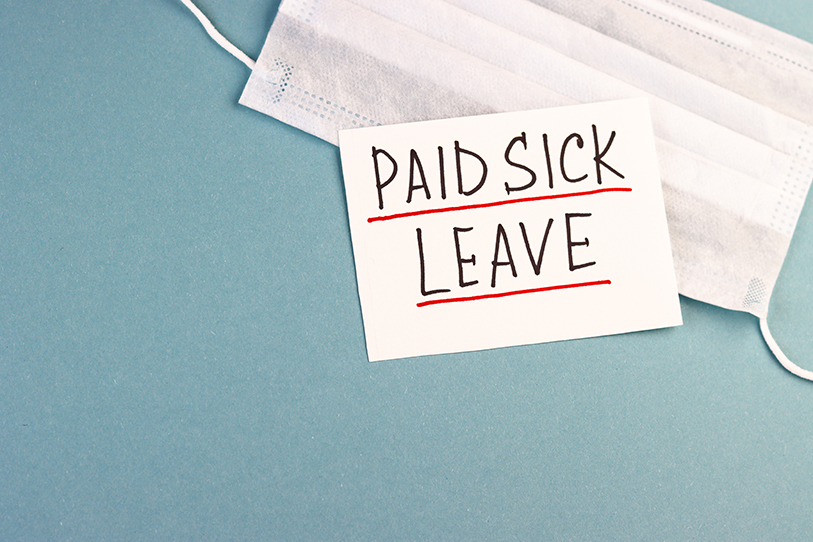On March 19, 2021, the Governor signed SB 95, bringing back the state’s COVID-19 Supplemental Paid Sick Leave — with some big changes. SB 95 significantly expands the number of employers required to start providing this leave (compared to the previous COVID-19 Supplemental Paid Sick Leave law (AB 1867)), provides a fresh bank of up to 80 hours of leave and adds several new qualifying reasons for which leave can be taken.
Employers must start providing this new leave on March 29, 2021, so they will need to get up to speed on this new law quickly.
Covered Employers
The new COVID-19 supplemental paid sick leave applies to all employers with more than 25 employees, a dramatic expansion from AB 1867, which applied to employers with 500 or more employees. It also separately covers certain in-home supportive service providers.
Employee Eligibility
All employees working for covered employers are eligible for leave. Compared to AB 1867, SB 95 increases the number of qualifying reasons for which employees can take leave. Now, employees may take paid sick leave if they’re unable to work or telework because they’re:
- Subject to a quarantine or isolation period related to COVID-19 as defined by an order or guidelines of the State Department of Public Health, the federal Centers for Disease Control and Prevention or a local health officer who has jurisdiction over the workplace.
- Advised by a health care provider to self-quarantine.
- Attending an appointment to receive a COVID-19 vaccine.
- Experiencing symptoms related to a COVID-19 vaccine that prevent the employee from being able to work or telework.
- Experiencing symptoms of COVID-19 and seeking a medical diagnosis.
- Caring for a family member who is subject to an order or guidelines, or who has been advised to self-quarantine.
- Caring for a child whose school or place of care is closed for COVID-19 reasons.
Employers cannot request a medical certification before granting COVID-19 supplemental paid sick leave. Employees are entitled to take leave immediately upon their request.
Leave Amounts
Full-time employees are eligible for 80 hours of COVID-19 supplemental paid sick leave.
Part-time employees are eligible for an amount of leave equal to the number of hours they’re normally scheduled to work in two weeks. If an employee works a varying schedule, they’re entitled to hours equal to 14 times the average number of hours the employee worked each day in the prior six months, or over the total time of employment if less than six months.
Rate of Pay
The rate of pay under SB 95 differs from the AB 1867 methodology.
For nonexempt employees, employers must pay the highest of the following rates:
- Rate calculated in the same manner as the regular rate of pay for the workweek in which the employee uses COVID-19 supplemental paid sick leave, whether or not the employee actually works overtime in that workweek.
- Rate calculated by dividing the employee’s total wages, not including overtime premium pay, by the employee’s total hours worked in the full pay periods of the prior 90 days of employment.
- The state minimum wage.
- The local minimum wage to which the employee is entitled.
For exempt employees, the rate of pay must be calculated in the same manner that the employer calculates wages for other forms of paid leave.
The amount of pay is capped at $511 per day and $5,110 total per employee.
Leave Interactions
SB 95 provides a fresh bank of paid leave, in addition to already existing paid sick leave under California’s Healthy Workplaces, Healthy Families law. Employers cannot require an employee to use other paid or unpaid leaves before the employee uses COVID-19 supplemental paid sick leave.
The bill specifically addresses Cal/OSHA’s COVID-19 Emergency Temporary Standard, stating that in order for employers to comply with the standard’s requirement to maintain the earnings of employees exposed to COVID-19 and excluded from the workplace (also referred to as exclusion pay), employers may require an employee to first exhaust their COVID-19 supplemental paid sick leave.
The law also contains an offset provision stating that if an employer has already provided an employee with supplemental paid leave after January 1, 2021, for any of the qualifying reasons included in this law, and the amount is equal to or greater than that required by this law, then the employer may count the hours of the other paid benefit or leave towards the new requirement. But, because SB 95 provides a fresh bank of leave, any leave granted last year under AB 1867 or the Families First Coronavirus Response Act (FFCRA) does not count towards the new leave obligations.
Notice and Wage Statements
Employers are required to provide notice to their employees informing them of their rights to supplemental paid sick leave under the new law. The Labor Commissioner created a model notice that employers may use for this purpose. Employers may download the posters and distribute as appropriate, including sending the notice electronically to employees who are telecommuting. Employers need to provide notice before March 29, 2021.
Additionally, the COVID-19 supplemental paid sick leave must be reflected on employees’ wage statements. The new law specifies that the COVID-19 supplemental paid sick leave must be set forth separately from other paid sick days. For employees with part-time or variable schedules, the law allows employers to do an initial calculation of leave time available with the notation “variable” next to it. Employers must still provide updated calculations when employees request to use their COVID-19 supplemental paid sick leave.
Effective Dates and Retroactivity
As a “budget bill,” the law took effect when it was signed on March 19, 2021, but it provides a ten-day grace period, meaning employers must start providing leave on March 29, 2021.
The bill states that the law applies “retroactively to January 1, 2021” in order to “protect the economic well-being of covered employees who took leave” after the expiration of the FFCRA and AB 1867. As such, employers will have to make retroactive payments for leave taken for any of the qualifying reasons between January 1, 2021, and March 28, 2021, “upon oral or written request of the employee.”
The employee must initiate the retroactive payment by submitting an oral or written request. The payment must be paid on or before the payday for the next full pay period after the oral or written request by the employee and must be reflected on the applicable wage statement. Any such retroactive payment will count towards the total number of COVID-19 supplemental paid sick leave required by this law.
The new California COVID-19 supplemental paid sick leave expires on September 30, 2021.
Takeaways for Employers
This expansive new leave mandate for employers could be costly and administratively burdensome, particularly when it comes to the retroactive component. Employers should consult with legal counsel on implementing this new leave requirement, which begins March 29, 2021, as well as potential interactions with other laws and ordinances. Employers may be able to take advantage of the new federal extension of FFCRA tax credits, but the voluntary extension of FFCRA comes with its own issues to consider with the help of legal counsel.
Employers should review and continue to monitor the Labor Commissioner’s COVID-19 Supplemental Paid Sick Leave FAQs for updated guidance on the new leave.
James W. Ward, Employment Law Subject Matter Expert/Legal Writer and Editor
CalChamber members can read more about California’s Health Workplaces, Healthy Families Act in Paid Sick Leave in the HR Library. Not a member? See how CalChamber can help you.







